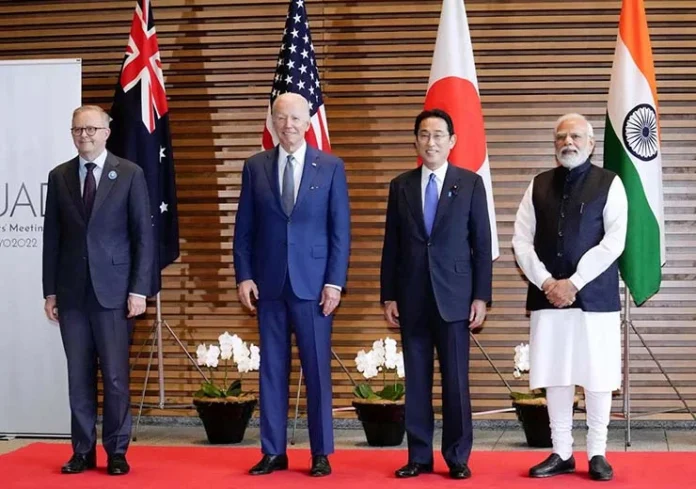Geopolitical Landscape
Nations around the world are witnessing uncertainties hitherto unheard of in recent history. The storming of the Capitol Hill, Russian incursion into Ukraine, the forced eviction of the ruling leadership in Sri Lanka, and the unending pandemic that has been the sole reason for what one can loosely claim as the cause for global economic meltdown, are events triggering a worldwide phenomenon of acute economic deprivation, obfuscation of the rule of law, food insecurity and increasing unemployment, death and destruction. It is nothing but global chaos, furrowing through deep fissures and contradictions amidst a morbid global system of governance emanating from nations pursuing their self interest.
In the Indian context the country is steering through these rough waters with measured diplomatic alacrity in its best national interest. The hard line response to the belligerence of China on its eastern borders, the ambivalence in denouncing Russia as the aggressor against the unified outcry of the world at large, the purchase of cheap oil from Russia undermining the sanctions imposed by the western lobby, the outreach to a neighbour under severe political and economic crisis in Sri Lanka, its perceived stand point in aligning with the QUAD as a show of solidarity against China, its stated pre-eminence in the ASEAN and the recent delinking of the rupee from the dollar for international trade as well as to arrest the dwindling currency valuation against the dollar only speak of Indians diplomatic independence as part of its strategy of strategic partnership built on the edifice of need based alignment. This has made its foreign policy an enigma to be closely analysed.
For starters, given these challenges, India also has the sceptre of terrorism, an ongoing proxy war that has no tangible end state. India’s military hardware needs bolstering to counter Chinese belligerence necessitating a fine balance in international relations besides insulating it from any sudden logistic breakdown in times of crisis. What is even more important is to manage the threshold of Indian political tolerance within acceptable democratic limits whose precipice can be squarely attributed to these global events.
All this has prompted a renewed strategic outlook where the country’s foreign policy has to be focussed on national interest and the interest of its people. Thus, the realignment of India’s grand strategy has seen a distinct shift from the erstwhile non aligned stature to one of strategic partnership that espouses political, diplomatic and economic autonomy in choosing its need based alliances, concurrently developing indigenous capabilities for self reliance and self sufficiency in all respects while ensuring international coexistence.
India’s Foreign Policy Paradigm
For decades Indian foreign policy was guided by one overarching principle: non-alignment. It was considered as a central component of Indian identity in global politics. The doctrine was against direct entanglement in the Cold War and prevented alignment with either of the power blocks -United States or the Soviet Union. It served the cold war era of the 60s and 70s, where India, a nascent democracy post colonial deprivation, sought to embrace both superpowers for its self interest of domestic stabilisation and against growing Chinese threat. But soon the waning Chinese influence grew into an anti-American ideology divorced from India’s national interests. Over time the emergence of economic globalisation and international terrorism faded the Cold War memory. This led to the dilution and the non-attractiveness of the non-alignment doctrine, falling even further into disfavour with no tangible outcome. Today, the broad consensus in India is that this doctrine has long outlived its purpose, and has been quietly succeeded by a new foreign policy principle: “Strategic Autonomy” or more precisely “Strategic Partnership”.
Strategic Autonomy
In broader terms Strategic Autonomy prioritizes self-sufficiency, self reliance and sovereign independence. It seeks to keep Indian decision-making insulated from external pressures while moving beyond some of the ideological constraints of non-alignment and its inherent aversion to foreign partnerships. It is an exercise of choice driven purely by sovereign considerations and interest. In fact the heart of this strategy is self-consciously aimed at emphatically averring to the principle of “Strategic Partnership” in an uncertain world, unequivocally focussed on advancing its own national interests, driven by identifying and exploiting opportunities created by global consensus and/or contradictions while reducing its own dependencies, so as to extract as much gains from as many global ties as possible. This is not to distance India as a friendly country that professes peaceful coexistence as an apostle of its democratic principles. However, that notwithstanding, India has volatile borders with its neighbours resulting in enduring Pakistan sponsored proxy war on the west and a belligerent China on the east. The fact that India is presently disadvantaged in its power rivalry with China, it has chosen to leverage the external environment to address these bilateral imbalances implying that India has reached out in multiple directions to maximize its gains and to safeguard its interest.
The quadrilateral dialogue with the United States, Japan, and Australia is a classic example of this outreach. In addition the growing convergence of U.S.-Indian strategic cooperation since the onset of the Sino-Indian crisis clearly demonstrates that a need based alliance, even if asymmetric, is indeed possible despite decades of animosity. It is further corroborated by the fact that despite India’s ambivalence in denouncing Russian aggression as opposed to US rallying countries around the world to show their unity and resolve in support of Ukraine’s sovereignty, independence, and territorial integrity, as well as in defending rules-based international order, the recent congressional waiver to India under CAATSA(Countering America’s Adversaries Through Sanctions Act) for its purchase of S-400 missile defence system from Russia, to deter China is a unique decision taken to help India and is a case in point.
While these are straight jacket approach that defines strategic autonomy, it is also suggestive of capitalising on benefiting from the emerging rifts in the international system that throw up multiple challenges as well as opportunities. The opportunities are not only to respond but to actually leverage on the rift for the greater cause of furthering India’s national interests. For instance China’s rise has disturbed the U.S.-led international order in more ways than one unseen since the end of the Cold War. The evolving differences between the US and China has generated a host of strategic challenges as well as opportunities for India. The opportunity is the convergence of US-India relations while the challenge is the hard lining stance by China on the border issues. In real terms, the principle of strategic autonomy remains largely curtailed due to domestic compulsions. Given this power ambivalence, it is axiomatic that situational calibration and reframing of the strategy is but natural.
Standing amongst comity of Nations
Having outlined the strategy of partnership based on strategic autonomy in diplomatic decision making, it is increasingly clear that the responses by the big five towards India based on these developments suggest that India is no longer a strategic middleweight. It is a strong and vibrant democratic power being nuclear-armed and possesses the world’s third-largest military budget and fifth-largest economy. Given its current GDP growth rate it will not be surprising to anticipate that by mid-century India may be equated to China and the US as their only geopolitical peer. More importantly, these powers are now on a much clearer positions on India’s strategic horizon, its most daunting security challenge and its most promising economic partnership. Needless to deduce that India is in the midst of a generational paradigm shift in its global standing where big powers are creating space for a substantive strategic need based partnership with India, be it the US, Russia or European nations who are increasingly responsive to India’s sensitivities and respect its diplomatic independence. This genuine understanding also predicates the fact that India has no territorial aspirations but to safeguard its own besides the need to ensure fairness, justice, equality and prosperity of its people and wish the same for others as well. Given these postulates, developing nations are also leaning towards India as an alternative to the big power blocks in times of crisis. For the most part India has, in recent times, reached out to global crisis wherever possible. Most recent are its effort to fill the void of global wheat shortage caused by the Ukrainian war. Its vaccine diplomacy is unique and unparalleled by international standards. The neighbourly outreach to mitigate the political and economic crisis in Sri Lanka is humanitarian. While similar soft approach towards Nepal and Myanmar are strategised towards thwarting Chinese attempt to strengthen the string of pearls by design. To summarise “Strategic Partnership” gives India the leverage to engage America, manage China, cultivate Europe, reassure Russia, bring Japan and Australia into play, draw neighbours in, extend the neighbourhood, and expand traditional constituencies of support, while continuing to grow in a democratic system built on native beliefs and traditions.
On the face of it, while these initiatives vindicate India’s importance to the international system at a time of heightened geopolitical volatility, it also runs the risk of becoming increasingly marginalized in a galvanised global order fuelled by the Russian invasion and the Russia-China-US strategic rivalry, tacitly allowing for the resurgence of a tripartite Cold war. Developments in the Indo-Pacific and the South China Sea, can be seen as a microcosm of this. In this quagmire India’s neutrality centred on principled governance works in its favour. Hence the world at large cannot afford to ignore it, given its size and the opportunities available to exploit its economic potentials supported by a dexterous human capital.
India’s economic Landscape
Therefore, in the context of India’s philosophy of strategic partnership an overview of the global economic landscape becomes necessary. A striking revelation is the fact that as the world crosses the $100 trillion mark, the global economy is increasingly dominated by Asian economies, China and India in particular while western economies have been proportionally shrinking over time, despite commanding a large share of it. In fact the picture is distinct, when viewed from a Purchasing Power Parity (PPP) perspective, regarded as a better measure of the true income than GDP at market rates. China would then be number one with $30.18B (according to IMF), America at number 2 at $25.3B and India at number 3 at $11.7B. On the flip side the headwinds created by soaring energy prices due the current conflict has resulted in high inflation which in turn is bound to alter the fundamentals of global economy making it extremely difficult for developing economies to sustain. In fact a rampant dollar at a two-decade high is crushing most currencies and sharply whittling their buying power in international markets leading to fears of an economic downslide and its sustainability.
The crisis in Sri Lanka is a result of dwindling foreign exchange reserves defaulting on debt servicing which in turn has spurred domestic inflation, fuel shortage and lack of basic essentials. This coupled with poor governance, corruption and gross mismanagement has led to the present political and economic collapse. Perceptibly, a number of developing countries are also exhibiting similar economic malaise, that include typical debt crisis, collapsing currencies, high borrowing prices, unchecked inflation and sharp squeeze of foreign exchange reserves. In this conundrum, an economic assessment shows that while Sri Lanka has already collapsed Lebanon, Russia, Belarus, Pakistan, Sudan and Zambia are closely following suit and at least a dozen countries are on the horizon.
In sharp contrast, the Indian economy is growing to become the world’s third largest economy by 2030 or thereabouts despite its domestic challenges of quality of human capital, healthcare, education and employability; agricultural productivity and modernisation; and administrative reforms including law and order. Nonetheless, despite these challenges, it is reasonably predicted that it will grow to be a $4.5 trillion economy by 2030-2035 which will no doubt have a significant strategic implication. However, given the current economic turbulence, the big lesson to learn for India from this situation, is to be self-sufficient and self reliant across the industrial and agricultural spectrum. That notwithstanding the most important lesson is to maintain fiscal prudence and practice responsible governance eschewing the culture of freebies for political gains thereby ensuring a healthy revenue generation as the fundamental of good governance.
However, in spite of India’s projected growth profile, the country has to deal with a set of unique economic challenges. First, Indian oil reserves can last a mere 74-day period necessitating a substantial increase for at least 180 days given the ongoing fuel crisis around the world created due to the Russia-Ukraine war. Reducing fossil fuel dependence is paramount. Second, India seems to be on the brink of a power crisis due to coal shortage at a time when the country is dependent on fossil fuels for more than 60 per cent of power generation. Other energy sources like solar, wind and wave energy have to be explored and accelerated. Third, the Indian rupee has depreciated 5.9 per cent in 2022, which will further result in decreasing foreign exchange reserves that have already plummeted to the lowest value in recent past. Thus trading in rupees to delink the rupee from the dollar for international trade is a major step in arresting the falling currency valuation against the dollar. Fourth, Indian inflation has soared to 7.79 per cent in April 2022, which is a cause for serious concern and has to be checked at all costs. Lastly, industrial production should be increased in tune with the government’s plan to produce goods worth$1 trillion by 2025, and at the same time increase exports to earn sufficient foreign exchange reserves to deal with debt liabilities and the ever-increasing import cost. In terms of its foreign policy initiatives its design to reach out to as many players as possible for servicing its own national interests is in the right direction. Thus the doctrine of “Strategic Partnership” is the way forward.
Conclusion
Given the global strategic flux, the boldness with which India must play the international power game is ultimately what makes India’s doctrine of “Strategic Partnership” distinctive. Unlike yesteryears of India’s perceived weakness it has to jettison it for being more assertive and seek to determine agendas and outcomes to further its own national interests as well as to play a balancing role. As new equations come into play it has to transform itself to be daring enough to leap into the scrum. To do so is not only advantageous but also ethical in more ways than one in the international order.
Thus a foreign policy of strategic partnership is a spirited Indian pursuit of multi-alignment enabling India to overcome risks by combining national strengths and external relationships in a virtuous interaction, where all major international relationships are centred on strategic convergence of needs and interests rather than knee jerk issues based tactical convenience. Such an energetic and participative approach stands in stark contrast to non-alignment, a policy of abstention or non-involvement that was restrictive albeit regressive in a turbid world of global politics.
–The writer is a former GOC-Indian Army and presently a Strategic Consultant, Principal Advisor. Views expressed are personal and do not necessarily reflect the views of Raksha Anirveda
–The writer is a former GOC of the Indian Army and presently serves as a Strategic Consultant and Principal Advisor. The views expressed are of the writer and do not necessarily reflect the views of Raksha Anirveda










